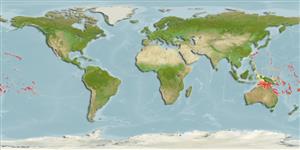Common names from other countries
Environment: milieu / climate zone / depth range / distribution range
Ökologie
seewasser; brackwasser riff-verbunden; standorttreu; tiefenbereich 0 - 60 m (Ref. 48391). Tropical; 28°N - 25°S
Pacific Ocean: mainly in tropical waters.
Size / Gewicht / Alter
Maturity: Lm ? range ? - ? cm
Max length : 15.0 cm TL Männchen/unbestimmt; (Ref. 48391)
Rückenflossenstacheln (insgesamt) : 14; Rückenflossenweichstrahlen (insgesamt) : 16 - 18; Afterflossenstacheln: 3; Afterflossenweichstrahlen: 17 - 18.
Found in clear lagoon and seaward reefs from the lower surge zone to a depth of 57 m (Ref. 1602). Benthopelagic (Ref. 58302). Secretive and stays near shelter (Ref. 1602). Has been reared in captivity (Ref. 35409). Feeds on algae. Forms harems of 3-7 individuals. Frequently exported through the aquarium trade (Ref. 48391). Minimum depth reported taken from Ref. 128797.
Life cycle and mating behavior
Maturities | Fortpflanzung | Spawnings | Egg(s) | Fecundities | Larven
Randall, J.E., G.R. Allen and R.C. Steene, 1990. Fishes of the Great Barrier Reef and Coral Sea. University of Hawaii Press, Honolulu, Hawaii. 506 p. (Ref. 2334)
IUCN Rote Liste Status (Ref. 130435)
CITES (Ref. 128078)
Not Evaluated
Bedrohung für Menschen
Harmless
Nutzung durch Menschen
Fischereien: kommerziell; Aquarium: Kommerziell
Tools
Zusatzinformationen
Download XML
Internet Quellen
Estimates based on models
Preferred temperature (Ref.
115969): 25.4 - 28.7, mean 26.9 (based on 86 cells).
Phylogenetic diversity index (Ref.
82804): PD
50 = 0.5000 [Uniqueness, from 0.5 = low to 2.0 = high].
Bayesian length-weight: a=0.03090 (0.01359 - 0.07026), b=2.89 (2.70 - 3.08), in cm Total Length, based on LWR estimates for this (Sub)family-body shape (Ref.
93245).
Trophic level (Ref.
69278): 2.8 ±0.31 se; based on food items.
Widerstandsfähigkeit (Ref.
120179): mittel, Verdopplung der Population dauert 1,4 - 4,4 Jahre. (Preliminary K or Fecundity.).
Fishing Vulnerability (Ref.
59153): Low vulnerability (10 of 100).
